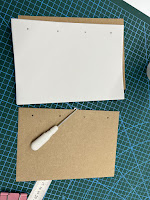Sketchbook is one of the most important tools for us Architecture students. Making a sketchbook by ourselves is a meaningful thing. We can express our attitude to Architecture and show our idea and concept by making a sketchbook of our own styles.
First, I went to the store to choose suitable paper for internal pages. I decided to use three kinds of paper in total, sketch paper, tracing paper, and Chinese art paper. The reason why I use Chinese art paper is that it can meet the need for gouache. Therefore, this sketchbook can be multiple functions
As for the binding, I chose to use string to bind the book. Because the way of string thread stitching can highlight the handmade feeling. What's more, I can better experience the process of making a book. It is also an important skill for Architecture students.
Unfortunately, I am still exploring the best way to make the cover for this sketchbook. I have thought of using cloth to wrap the board but I have not found a suitable material. That's why I labeled Still under progress in the title.
.





Comments
Post a Comment